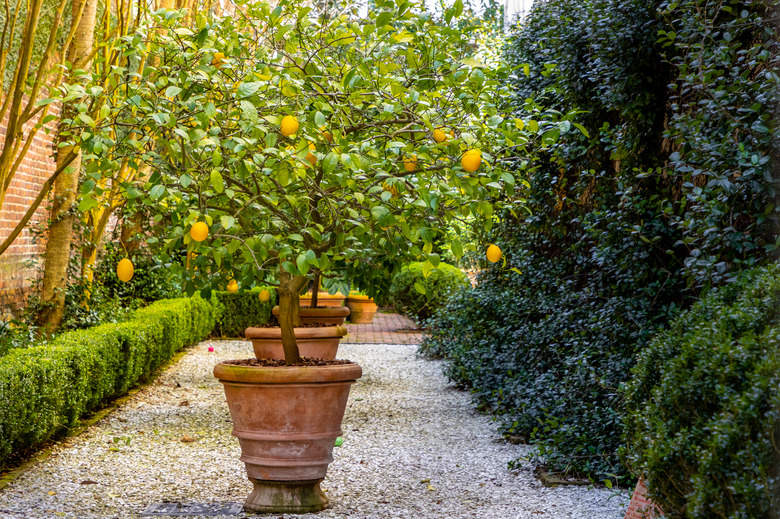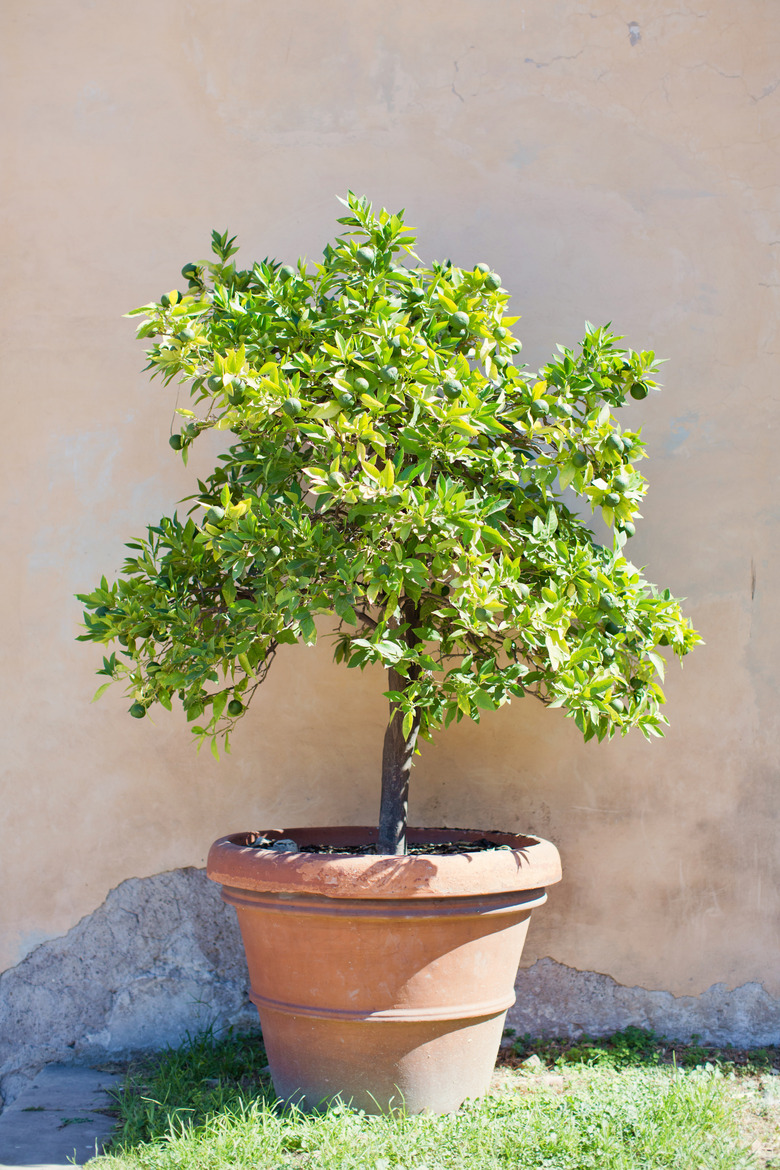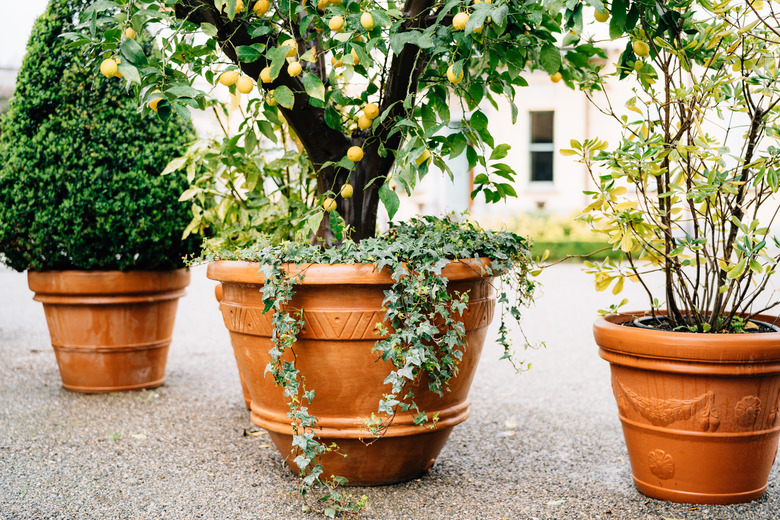Growing Fruit In Containers: Tips And Best Types
We may receive a commission on purchases made from links.
It's a popular survival strategy — and a commonsense one — to maintain at least one home garden for food in case of an emergency (or just to save money), but people who do this often forget about growing fruit, and even hardened survivalists need fruit. Fruit contains essential nutrients, like potassium, vitamin C, fiber and folate, and eating fruit lowers blood pressure and cleans the colon. You don't need a spare plot in your backyard — or even a backyard — to grow fruit because fruit trees will grow quite happily in containers, and all you need for container gardening is a sunny spot on your deck or in your sunroom.
You have to be careful about choosing cultivars because not all are self-fertile, and if you grow one that isn't, you'll need extra space for growing a companion tree next to it to pollinate it, or you won't get any fruit. There's no need to worry if you have a small space because there are many self-fertile varieties you can grow, and even if you have your heart set on growing a type of apple that relies on cross-pollination, there are ways to deal with limited space. One of the simplest is to put your containers on wheels so you can shift them around as needed, and another is to purchase a tree that has cultivars grafted onto it. Of course, varieties that aren't self-fertile need agents such as birds, bees and wind to pollinate them, and that should factor into your decision about where to locate the containers.
Fruit trees need to be in full sun, so choose the sunniest part of your deck or garden to grow them and make sure you use containers with drainage holes on the bottom or sides because they need well-draining soil. One of the challenges you face when you grow your own fruit is maintaining proper soil moisture, but it isn't a huge challenge. Just watch the soil carefully and water only when it dries out, and you'll find growing fruit as easy as growing lettuce — and that's easy!
Containers for Growing Fruit
Containers for Growing Fruit
Most people who grow fruit trees in containers want the containers to be movable so they can relocate a tree to follow the sun or bring it indoors when the weather turns cold, but the container also has to be sizable enough to support the tree. The ideal container size is 10 to 15 gallons unless you fit the container with wheels, in which case you might want a larger one. However, it's usually unnecessary to use a very large container because potted fruit trees are generally dwarf varieties grown from dwarf rootstock, which limits the height of the tree and optimizes fruit yield.
Containers made from a rot-resistant wood species, such as cedar or redwood, aren't as heavy as clay pots and don't heat up in the sun as quickly as plastic ones. Versailles planters, which have removable sides, are especially useful because they allow for addition or removal of soil without having to uproot the tree.
The Best Soil for Growing Fruit
The Best Soil for Growing Fruit
Most fruit trees grow best in mildly acidic soil, and when planting anything in containers, including fruit trees, you can't do better than to use commercial potting soil from your local garden center. Most mixtures already contain fertilizer, so you don't need to add more when planting the tree, although you may want to give the plant a boost later in the season when its roots get established.
Topsoil generally isn't a good choice for container gardening because it tends to compact when you water it, turning into a dense mixture that prevents water from getting to the roots. Instead, the water seeps along the outside perimeter of the pot and drains through the drainage holes in the bottom, leaving the tree thirsty and underdeveloped. If topsoil is all you have, mix it with peat moss or composted organic matter to loosen it, fortify it and reduce the silt content. Fruit trees love sandy soil because it drains well, so you can add also add sand to your potting mix. A good recipe for making your own soil for growing fruit consists of:
- 2 parts peat moss or rotted pine bark
- 1 part sand
- 1 part perlite
- 1 part compost
- 1.6 ounces dolomite lime per cubic foot of soil
- 5.6 ounces 17-6-10 fertilizer per cubic foot of soil
Planting and Maintaining Fruit Trees in Containers
Planting and Maintaining Fruit Trees in Containers
The best time to plant or transplant a fruit tree is in early spring, which gives the tree's roots the entire warm season to get established before winter dormancy. Place the tree in the center of the pot and hold it straight while you fill in dirt and tamp it down to eliminate air pockets. Then, give the tree a thorough watering.
If you plant a young tree in a small pot, it will probably get root-bound, which hinders vertical growth and adversely affects fruit production. When this happens, you'll want to repot in a larger container. Even if a tree isn't root-bound, it's a good idea to repot it every two or three years to stimulate the root system. The roots can't spread freely as they would if the tree were planted in the ground, so repotting is necessary to untangle each bare root so it can draw in more nutrients. You can usually do this by scraping the root ball with your fingers or a tool, such as a hand fork. When the tree is growing vigorously, you'll want to prune it yearly in late winter to stimulate fruiting.
Soil in containers tends to dry out more quickly than it does in the ground, especially if you use plastic containers and place them in hot, sunny spots, so it's important to monitor the trees and water them regularly, but don't overdo it. Watering too often is as harmful as not watering often enough. Keep an eye on the pots and water when the soil dries out, which may be every day, or it may only be two or three times a week. The trees will need less water in the winter, especially if you add mulch to retain moisture and keep the roots warm.
Chill Hours and Fruit Production
Chill Hours and Fruit Production
Because you can move containers indoors in winter, you aren't as restricted by growing zones as you are when planting trees in the ground. You can also create microclimates within your growing zone by placing containers next to walls that reflect sunlight or in shady spots to create cooler conditions. Your overall climate zone is still important, though, because fruits need varying numbers of chill hours (hours of temperatures between 32 and 45 degrees Fahrenheit) to develop, and southern zones may not have the requisite number of cold days for production of certain types of fruit. Because tropical fruits don't require a period of cold temperatures to develop, it's easier to grow them in cooler zones than it is to grow fruits that thrive in northern zones in warm climates.
Apples Trees Are Great for Northern Zones
Apples Trees Are Great for Northern Zones
Maybe you aspire to grow prize apples (Malus spp.) like Japanese growers do, wrapping the apples while still on the tree to protect them from pests. You can grow the trees in containers, but be sure to choose a self-fertile variety if you're short on space. Apples generally need more chill hours than other fruit — from 500 to 1,000 — so they are more suited to northern growing zones, but there are selections that require fewer hours. The Dorsett Gold, for example, needs only 300 hours, so it's a good choice for people in the warmer climates of zones 6 to 9.
Citrus Fruit as Houseplants
Citrus Fruit as Houseplants
Lemons (Citrus limon), limes (Citrus aurantiifolia) and sweet oranges (Citrus sinensis) like warm weather and generally won't tolerate the cold in zones 8 and below, so if you want to have a supply of fresh citrus fruit for juicing, grow the trees in containers in a sunny spot in the house. You can start the trees from seeds you save from your favorite fruits, but this method isn't reliable for producing fruits true to the look and taste that you ate. It's best to graft a cutting from a variety you like onto the rootstock of another variety or buy an already-grafted tree. Citrus trees can grow as large as you want if you keep repotting them in larger pots. The tree produces fragrant flowers in early spring, and if all goes well, fruit should appear the following winter.
Watermelons in a Container? Sure!
Watermelons in a Container? Sure!
Watermelons (Citrullus lanatus) don't grow on trees but on creeping vines that can take a lot more space than a container has to offer, so the simple work-around is to train them to grow vertically on a trellis. The vine has a deep taproot, so you need a container with at least 2 feet of moist, loamy, almost sandy soil mixed with plenty of organic matter, and the trellis should be a minimum of 4 feet high. The plant produces both male and female flowers, and bees usually take care of cross-pollination, but you'll probably want to do it yourself to make sure that the plant bears fruit.
Grow Stone Fruit From Pits
Grow Stone Fruit From Pits
Stone fruits in the Prunus genus include plums, nectarines, peaches, cherries and apricots — the ones with the large pits, also called stones. These are actually viable seeds, although they require a lengthy period of stratification (about three to four months) at temperatures between 34 and 40 degrees, and the seeds also have to be softened by scarification, which means scratching or cutting. Properly prepared seeds will sprout, and they can then be planted in organic potting soil to grow into trees. Many stone fruits are self-fertile, but it's good to sow more than one seed to ensure that at least one grows into a healthy tree and to guarantee successful pollination and fruit production. It's better to grow two trees, even with self-fruitful selections, to boost pollination and increase the yield.
A Fig for All Seasons
A Fig for All Seasons
Figs (Ficus carica) are some of the easiest fruits to grow in containers because they don't mind having their roots confined. Fig trees can get quite large, but you can use a simple technique called root pruning to control growth so you don't have to continually repot the tree in a larger pot. Simply uproot the plant every few years, trim back the roots by about a third and return the plant to the same pot full of fresh potting mix. Rather than damaging the plant, this technique actually stimulates growth and usually results in a growth spurt and production of extra fruit. Figs grow best in zones 8 through 10, but many cultivars are hardy to zone 7. Chicago fig tree (F. carica 'Chicago Hardy') is one of the hardiest cultivars, surviving winter outside to zone 5 or 6, depending on microclimate and mulching.
References
- The National Gardening Association: Fruit Trees in Containers
- USDA MyPlate: Fruits
- Empress of Dirt: How to Grow a Peach (or Plum) Tree From the Pit
- Empress of Dirt: 12 Best Fruits and Berries for Patio Containers
- Urban Garden Gal: 11 Best Fruit Trees to Grow in Containers
- Stark Bro's: Growing Fruit Trees in Containers, Part 1


